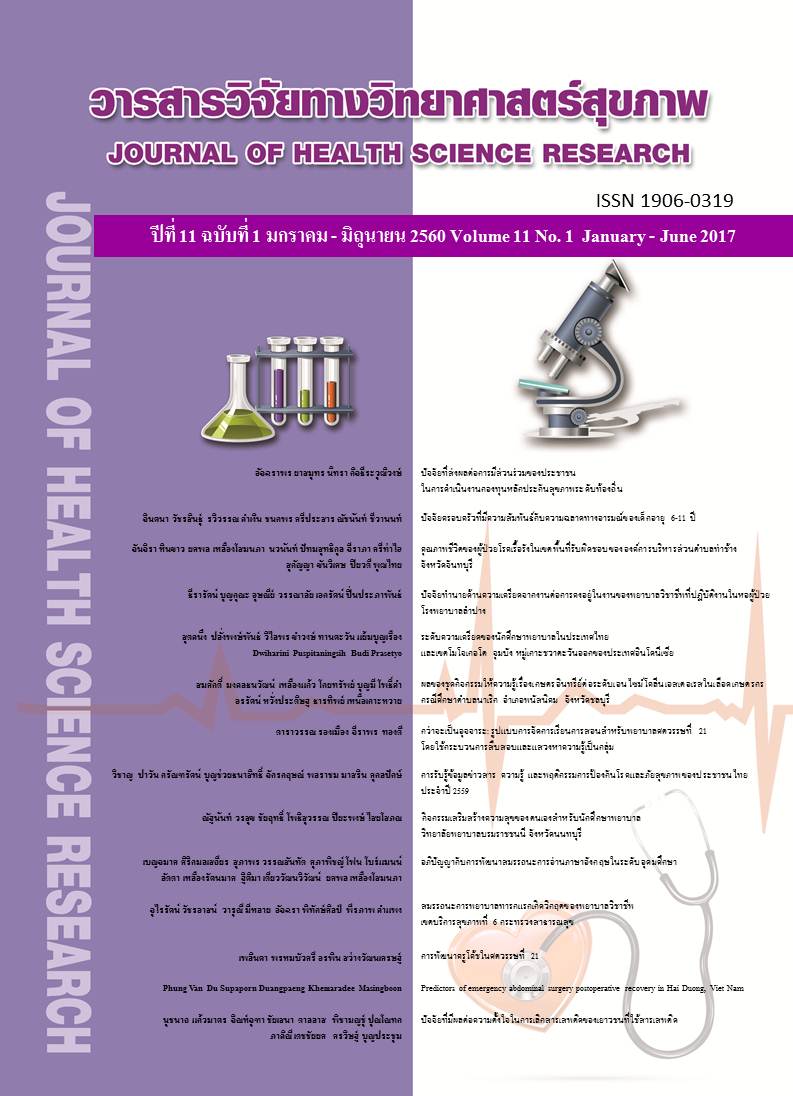การรับรู้ข้อมูลข่าวสาร ความรู้ และพฤติกรรมการป้องกันโรคและภัยสุขภาพของประชาชนไทย ประจำปี 2559
Main Article Content
บทคัดย่อ
การสื่อสารเรื่องโรคและภัยสุขภาพนับเป็นภารกิจหลักที่สำคัญประการหนึ่งของสำนักสื่อสารความเสี่ยงและพัฒนาพฤติกรรมสุขภาพ กรมควบคุมโรค กระทรวงสาธารณสุข การวิจัยเชิงพรรณนาครั้งนี้มีวัตถุประสงค์ เพื่อศึกษาการรับรู้ข้อมูลข่าวสาร แหล่งของการรับรู้ข้อมูลข่าวสาร ความรู้เรื่องโรคและภัยสุขภาพและพฤติกรรมการป้องกันโรคและภัยสุขภาพ รวมทั้งปัจจัยที่มีความสัมพันธ์กับพฤติกรรมการป้องกันโรคและภัยสุขภาพของประชาชน กลุ่มตัวอย่าง จำนวน 2,692 คน ได้จากการสุ่มแบบหลายขั้นตอน เก็บรวบรวมข้อมูลโดยใช้แบบสอบถาม วิเคราะห์ข้อมูลโดยใช้สถิติ ร้อยละ ค่าเฉลี่ย ส่วนเบี่ยงเบนมาตรฐาน และสถิติสัมประสิทธิสหสัมพันธ์เพียร์สัน ผลการศึกษาพบว่า
1. การรับรู้ข้อมูลข่าวสารของกลุ่มตัวอย่างส่วนใหญ่อยู่ในระดับมาก การเปิดรับข่าวสารจากแหล่งข้อมูลข่าวสารอยู่ในระดับปานกลาง แหล่งของการรับรู้ข้อมูลข่าวสารมากที่สุดจากโทรทัศน์/เคเบิลทีวี รองลงมาเป็นสื่อบุคคล ได้แก่ เจ้าหน้าที่สาธารณสุข อาสาสมัครสาธารณสุข และเพื่อน/ญาติ/คนในครอบครัว
2. ความรู้เรื่องโรคและภัยสุขภาพของกลุ่มตัวอย่างในภาพรวมอยู่ระดับปานกลาง ส่วนพฤติกรรมการป้องกันโรคและภัยสุขภาพอยู่ในระดับมาก เมื่อพิจารณารายโรค พบว่า พฤติกรรมการป้องกันโรคไข้เลือดออก โรคพิษจากสารเคมีกำจัดศัตรูพืช และอุบัติเหตุจากการจราจรอยู่ในระดับมาก ส่วนพฤติกรรมการป้องกันโรคเอดส์/การติดเชื้อเอชไอวี อยู่ในระดับ ปานกลาง
3. การรับรู้ข้อมูลข่าวสาร แหล่งข้อมูลการรับรู้ข่าวสาร ความรู้เรื่องโรคและภัยสุขภาพมีความสัมพันธ์ทางบวกกับพฤติกรรมการป้องกันโรคและภัยสุขภาพในระดับต่ำ (r = .321, .171, และ .373 ตามลำดับ)
ผลจากการวิจัยครั้งนี้ สามารถนำไปใช้ในการวางแผนการสื่อสารความเสี่ยงและระบบเฝ้าระวังพฤติกรรมสุขภาพของประชาชนโดยเฉพาะในด้านการเผยแพร่ข้อมูลข่าวสารผ่านโทรทัศน์ เคเบิ้ลทีวีให้มากขึ้นเนื่องจากเป็นแหล่งที่ประชาชนเข้าถึงมากที่สุด รวมทั้งหารูปแบบที่หลากหลายในการเผยแพร่ความรู้เกี่ยวกับโรคและภัยสุขภาพเพื่อการเสริมสร้างพฤติกรรมสุขภาพที่เหมาะสมของประชาชนต่อไป
Abstract
Communications about diseases and health hazards is one of major missions of the Bureau of Risk Communication and Health Behavior Development, Department of Disease Control. This descriptive research aimed to study peoples’ perception of diseases and health hazard information, sources of information, knowledge of disease and health hazard, protecting behavior over diseases and health hazard, as well as factors relating to protecting behavior of diseases and health hazard. There were 2,692 subjects selected by multi-stage sampling. Data were collected using questionnaires developed by the researchers. Statistics, namely percentage, mean, standard deviation, and Pearson’s correlation coefficient were used to analyzed the data. The major study results were:
1. Subjects' perception of diseases and health hazard information was on a high level whereas. Information exposure was on a medium level. TV/ Cable TV was found to be source of information that people use mostly followed by personal media, including health personnel, health volunteers and friends/relatives/family members.
2. Knowledge of disease and health hazard was average. In overall, the subjects had supirior protecting behavior of disease. The results showed that the level of protecting behavior of the subjects relating to DHF, pesticide poisoning, and traffic accidents were on a high level. On the other hand, AIDS/HIV infection protecting behavior was medium.
3. The perception of information, information sources, and knowledge of diseases and health hazard had positive relationship with the diseases and low health hazard protecting behaviors (r = .321, .171 and .373, respectively)
The Department of Disease Control (DDC) may use the study results to plan about health risk communication and developing people's health behavior surveillances system especially about the distribution of information. The CDC should promulgate information about disease and health hazards via TV/Cable TV since both media are the source of information that people use the most. Moreover CDC should use various models of communication to disseminate knowledge of disease and health hazards in order to strengthen peoples' appropriate health behavior.
Downloads
Article Details
บทความที่ได้รับการตีพิมพ์เป็นลิขสิทธิ์ของวิทยาลัยพยาบาลบรมราชชนนี จังหวัดนนทบุรี
ข้อความที่ปรากฏในบทความแต่ละเรื่องในวารสารวิชาการเล่มนี้เป็นความคิดเห็นส่วนตัวของผู้เขียนแต่ละท่านไม่เกี่ยวข้องกับวิทยาลัยพยาบาลบรมราชชนนี จังหวัดนนทบุรี และคณาจารย์ท่านอื่น ในวิทยาลัยฯ แต่อย่างใด ความรับผิดชอบองค์ประกอบทั้งหมดของบทความแต่ละเรื่องเป็นของผู้เขียนแต่ละท่าน หากมีความผิดพลาดใด ๆ ผู้เขียนแต่ละท่านจะรับผิดชอบบทความของตนเองแต่ผู้เดียว


